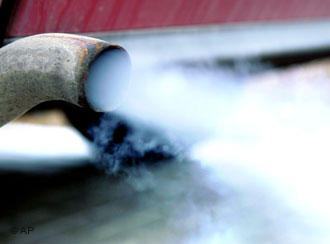Poluição do ar aumenta o risco de doenças cardiovasculares

[Por Henrique Cortez, do EcoDebate] A exposição à poluição do ar acelera o espessamento das paredes das artérias, que leva a doenças cardiovasculares, dizem os pesquisadores.
O estudo [Ambient Air Pollution and the Progression of Atherosclerosis in Adults] de pesquisadores da Keck School of Medicine da University of Southern Califórnia (USC), em colaboração com parceiros internacionais da Espanha e Suíça, e colegas, na Califórnia, foi publicado na revista PloS ONE.
No estudo, os investigadores descobriram que o espessamento da parede arterial, entre pessoas que vivem num raio de 100 metros (328 pés) de uma rodovia em Los Angeles, avançou duas vezes mais rapidamente do que aqueles que viviam mais longe.
“O fato de que podemos detectar progressão da aterosclerose em relação à poluição do ar, independente de outros fatores de risco bem estabelecidos, indica que fatores ambientais podem desempenhar um papel maior no risco de doenças cardiovasculares do que se suspeitava”, diz o co-autor do estudo Howard N. Hodis, diretor da Unidade de Pesquisa de Aterosclerose e professor de medicina preventiva na Keck School of Medicine.
A aterosclerose, ou enrijecimento e calcificação das artérias, é uma condição que leva a ataques cardíacos, derrames e mortes relacionados.
O artigo “Ambient Air Pollution and the Progression of Atherosclerosis in Adults“, publicado revista PloS ONE está disponível para acesso integral no formato HTML. Para acessar o artigo clique aqui.
Para maiores informações transcrevemos o abstract:
Ambient Air Pollution and the Progression of Atherosclerosis in Adults
Nino Künzli1,2*, Michael Jerrett3, Raquel Garcia-Esteban2, Xavier Basagaña2, Bernardo Beckermann3, Frank Gilliland4, Merce Medina2, John Peters4, Howard N. Hodis5, Wendy J. Mack4
1 Swiss Tropical and Public Health Institute (Swiss TPH), Basel, Switzerland, 2 Centre for Research in Environmental Epidemiology CREAL, Barcelona, Spain, 3 Division of Environmental Health Sciences, School of Public Health, University of California, Berkeley, California, United States of America, 4 Department of Preventive Medicine, University of Southern California, Los Angeles, California, United States of America, 5 Atherosclerosis Research Unit, Department of Medicine, University of Southern California, Los Angeles, California, United States of America
Abstract
Background
C1ross-sectional studies suggest an association between exposure to ambient air pollution and atherosclerosis. We investigated the association between outdoor air quality and progression of subclinical atherosclerosis (common carotid artery intima-media thickness, CIMT).
Methodology/Principal Findings
We examined data from five double-blind randomized trials that assessed effects of various treatments on the change in CIMT. The trials were conducted in the Los Angeles area. Spatial models and land-use data were used to estimate the home outdoor mean concentration of particulate matter up to 2.5 micrometer in diameter (PM2.5), and to classify residence by proximity to traffic-related pollution (within 100 m of highways). PM2.5 and traffic proximity were positively associated with CIMT progression. Adjusted coefficients were larger than crude associations, not sensitive to modelling specifications, and statistically significant for highway proximity while of borderline significance for PM2.5 (P = 0.08). Annual CIMT progression among those living within 100 m of a highway was accelerated (5.5 micrometers/yr [95%CI: 0.13–10.79; p = 0.04]) or more than twice the population mean progression. For PM2.5, coefficients were positive as well, reaching statistical significance in the socially disadvantaged; in subjects reporting lipid lowering treatment at baseline; among participants receiving on-trial treatments; and among the pool of four out of the five trials.
Conclusion
Consistent with cross-sectional findings and animal studies, this is the first study to report an association between exposure to air pollution and the progression of atherosclerosis – indicated with CIMT change – in humans. Ostensibly, our results suggest that air pollution may contribute to the acceleration of cardiovascular disease development – the main causes of morbidity and mortality in many countries. However, the heterogeneity of the volunteering populations across the five trials, the limited sample size within trials and other relevant subgroups, and the fact that some key findings reached statistical significance in subgroups rather than the sample precludes generalizations to the general population.
Citation: Künzli N, Jerrett M, Garcia-Esteban R, Basagaña X, Beckermann B, et al. (2010) Ambient Air Pollution and the Progression of Atherosclerosis in Adults. PLoS ONE 5(2): e9096. doi:10.1371/journal.pone.0009096
Editor: Landon Myer, University of Cape Town, South Africa
Received: October 9, 2009; Accepted: January 12, 2010; Published: February 8, 2010
Copyright: © 2010 Kuenzli et al. This is an open-access article distributed under the terms of the Creative Commons Attribution License, which permits unrestricted use, distribution, and reproduction in any medium, provided the original author and source are credited.
Funding: The funders had no role in study design, data collection and analysis, decision to publish, or preparation of the manuscript. The main author and data analyst (RG) had full access to the data and takes responsibility for the integrity of the data and the accuracy of the data analysis. NIH National Institute on Aging (grants R01AG-13860 (VEAPS); R01AG-17160 (BVAIT); R01AG-18798 (EPAT); National Health Lung and Blood Institute (U01HL-49298) (WELL-HART); Office of Dietary Supplements (VEAPS, BVAIT) and Office of Research on Minority Health (WELL-HART); National Institute of Environmental Health Sciences (5 P30 ES07048); Parke-Davis Pharmaceutical Research (TART); Wright Foundation; Hastings Foundation; Health Effects Institute; Catalan Institute for Research and Advanced studies (ICREA), Barcelona, Spain; Centre for Research in Environmental Epidemiology (CREAL), Barcelona, Spain; Spanish Ministry of Science and Innovation Program Juan de la Cierva (JCI-2007-47-767).
Competing interests: The authors have declared that no competing interests exist.
* E-mail: Nino.Kuenzli{at}unibas.ch
Por Henrique Cortez, do EcoDebate, 11/03/2010
Inclusão na lista de distribuição do Boletim Diário do Portal EcoDebate
Caso queira ser incluído(a) na lista de distribuição de nosso boletim diário, basta utilizar o formulário abaixo. O seu e-mail será incluído e você receberá uma mensagem solicitando que confirme a inscrição.
O EcoDebate não pratica SPAM e a exigência de confirmação do e-mail de origem visa evitar que seu e-mail seja incluído indevidamente por terceiros.
 |
| Participe do grupo Boletim diário EcoDebate |
| Visitar este grupo |
Fechado para comentários.